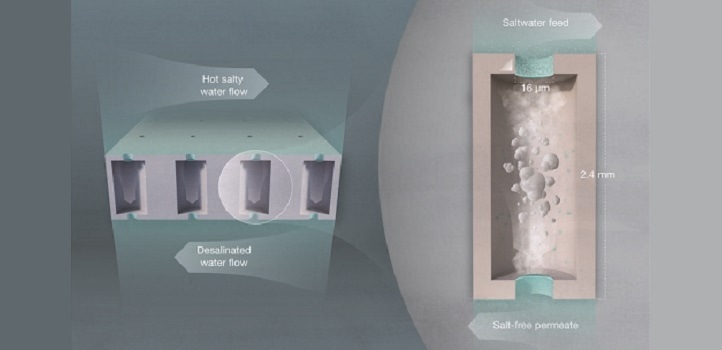Jul 1 2019
A new membrane created from water-wet materials comprises specially designed gas-entrapping pores that enable it to concurrently separate hot, salty from cool, pure water while aiding the transfer of pure vapor from one side to the other. This principle put together by KAUST scientists could result in greener, inexpensive desalination membranes.
 The membrane’s pores entrap air upon immersion in water, separating the liquids on either side and allowing the transport of only pure water vapor from the hot to the cold side. (© 2019 Ivan Gromicho)
The membrane’s pores entrap air upon immersion in water, separating the liquids on either side and allowing the transport of only pure water vapor from the hot to the cold side. (© 2019 Ivan Gromicho)
At present, super-water-repellent perfluorocarbon membranes are commonly used for a desalination process called membrane distillation (MD). But perfluorocarbons are non-biodegradable, expensive, and susceptible to fouling and damage at higher temperatures, explains KAUST postdoctoral fellow Ratul Das.
Focused on developing perfluorocarbon-free substitutes, Himanshu Mishra and his team of scientists at KAUST’s Water Desalination and Reuse Center took inspiration from two insects: springtails that reside in wet soils and seaskaters that are found in open oceans. Both have mushroom-shaped microtextures encompassing their cuticles and hairs that can freely entrap life-sustaining air in case the insects become submerged in water. “We mimicked those features onto water-wet (nonwater resistant) materials. The resulting surfaces robustly entrap air upon immersion in liquids. The idea of gas-entrapping membranes was born,” says Mishra.
Mishra’s team formulated protocols for forming vertical pores within thin sheets. The diameters of the pore inlets and exits were sharply smaller than the pore channels. “We began by toying with thin wafers of silicon to develop pores with these reentrant edges,” says Mishra. “These edges prevent liquids from intruding into the pores,” he explains.
We were able to achieve the function of perfluorinated membranes by harnessing this bio-inspired texture using water-wet materials, which might seem to defy conventional wisdom.
Himanshu Mishra, Scientist, Water Desalination and Reuse Center, KAUST
When a silicon membrane with simple cylindrical pores is submerged in water, it is totally filled within 1 second. Silica gas-entrapping membranes (GEMs), conversely, trap air robustly within their pores when immersed in water, and can stay undamaged for over six weeks.
The team then investigated using the same principle to a cheaper, easily mass-produced water-wet material called poly(methyl methacrylate) (PMMA), explains Sankara Arunachalam, a research expert in Mishra’s team. “PMMA-GEMs robustly separated streams of hot, salty feed from cold water for more than 90 hours with a salt rejection of 100 percent,” he says.
To our knowledge, this is the first-ever demonstration of MD membranes derived from intrinsically wetting materials. The benefits are obvious: common water-wet plastics, such as PMMA, are significantly cheaper than perfluorinated ones, are environmentally friendly, and can withstand harsher operational conditions. Interdisciplinary investigations are needed to assess the scalability and reliability of this approach.
Himanshu Mishra, Scientist, Water Desalination and Reuse Center, KAUST
The findings could reveal the potential of common water-wet materials for greener, economical desalination.